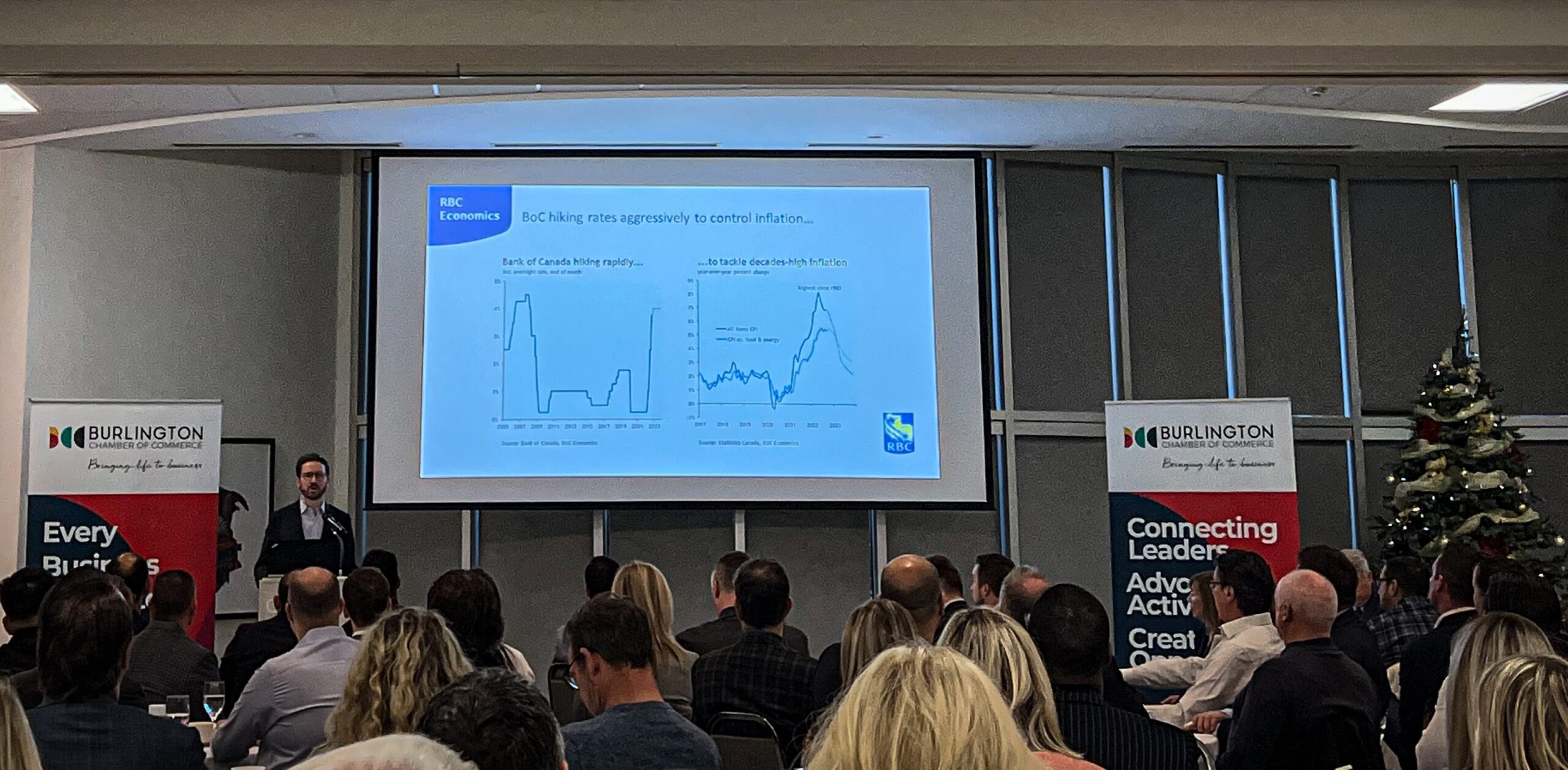“Brace for a bumpy landing,” said Josh Nye, at the 2023 RBC Economic Forecast event hosted by the Burlington Chamber of Commerce on November 30. The event was held at the Art Gallery of Burlington.
Nye, a senior economist at RBC, explains that he had hoped to have shared better news with attendees at the sold-out event, but the economic outlook will be challenging in 2023, especially during the first half of the year. It’s undeniable; factors such as inflation, the sharp rise in the cost of living, and significant increases to the Bank of Canada’s interest rates, a recession is going to be difficult to avoid. Not unique to Canada, the same will be experienced in the United States and Europe.
The good news? 2023 isn’t projected to hit a 1980s style recession, so we can all breathe a sigh of relief. It will certainly be somewhere between a hard and soft landing, what Nye referred to as a mild recession, and one that will continue to change consumer buying behaviours.
The Bank of Canada policy interest rate has increased aggressively throughout 2022, with yet another increase set to come this week. In fact, these rates have been hiked more aggressively than Canadians have experienced since the early 1980s. We are entering a more restrictive environment for the economy. “We think that they still have a bit further to go,” says Nye, “and actually their guidance has been that we should expect further interest rate increases in the coming months. Again, that next decision is next week and we think it’s going to be 25 basis points increase [0.25%].” Canadians should likely see that increase this week.
There are signs of the economy and inflation slowing, according to Nye, and with these conditions, it is projected that the Bank of Canada will hit pause after this next increase, and in 2023.

So, why the aggressive interest hikes? Nye says that it is because Canada has seen its worst inflation since the early 1980s. 2020 saw a slow-down of inflation, but as economies re-opened following the onset of the COVID-19 pandemic, 2021 saw a bit of inflation trickle in as services began rebounding; then, the early stages of 2022 saw Russia’s invasion on the Ukraine, impacting key commodity prices. More notably, food inflation has been extraordinary.
RBC does believe that the Bank of Canada will be successful at getting the inflation rate back to target over the next year or two, but the side effect of this will be a slowing economy in the interim. The slowing economic conditions will be especially notable during the first half of 2023 with a modest decline, but a recovery is projected during the second half of the year.
Loss of momentum is already starting to be noted. Housing, more specifically home re-sales, for example, has already started to slow, and that’s as a direct result of the rising interest rates. Still, there isn’t much evidence of so-called distress sales at this point, meaning that homeowners are not selling in haste out of necessity due to the higher interest rates on variable mortgages or new affordability factors.
Consumer buying behaviours will continue to be impacted, likely even more so, as we enter 2023. According to Nye, the rising cost of living will impact purchasing power and consumer confidence, as inflation continues to eat away at any wage gains. While wages are rising, it hasn’t been enough to combat inflationary increases. It certainly isn’t a good indication for consumer spending in the upcoming year.
Rising debt costs aren’t helping. In fact, there will be a lot less money for spending and that’s because of the cost of debt servicing, such as higher minimum payments on personal loans or high-interest products due to the Bank of Canada’s rate increases. Canada’s levels of household debt are still high, with household debt levels increasing substantially over the last decade. However, mortgage credit growth has been very strong, which suggests that Canadians are still able to carry mortgage debt, and that’s likely because they have been stress-tested at a higher rate at the time of their mortgage application. Nevertheless, any disposable income will be going towards debt servicing on loan products, and as a result, affecting the purchasing of any additional goods and services beyond that.
It isn’t all grim. Sure, better news would have been music to anyone’s ears, but given the events of the last couple of years, if a bumpy landing is to be expected following the latest economic and global turbulence, there might just be a light at the end of the tunnel. Perhaps after absorbing this week’s projected interest rate increase, the toughest part might start to be behind us if we can hang on for a little longer.




